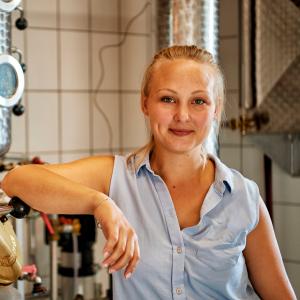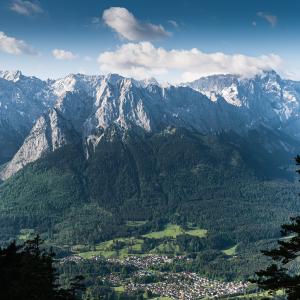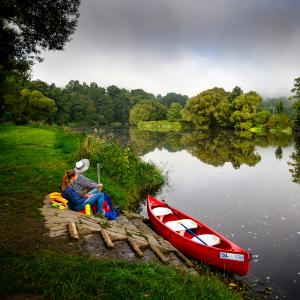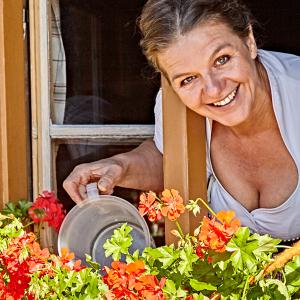In Upper Bavaria, the Free State shows itself off with some real superlatives: in the south, Germany's highest mountains reach up into the white-and-blue sky. Its largest city – Munich – vibrates in the heart of the region. And all around it, there are cosy little culture-oriented towns. Here are four towns and cities your customers certainly shouldn't miss!
Garmisch-Partenkirchen: a world-class ski resort on the Zugspitze
Skiing, ski jumping and Germany's highest mountain: Garmisch-Partenkirchen lies at the foot of the Zugspitze (2,962 m), and is Bavaria's best known ski resort. Skiers can choose between the glacier skiing region on the Zugspitze and the Garmisch Classic region. The latter is laid out on three mountains – the Hausberg, the Kreuzeck and the Alpspitze. But non-skiers too will find plenty of adventure in this ski resort in any season of the year. For example, they can take the Alpspitzbahn cable car up to the viewing platform AlpspiX. The AlpspiX is a free-floating skywalk with a glass pane at the end which reaches 25 metres out over the Höllental ravine – with a spectacular panorama. In the district of Partenkirchen, with its lanes and colourful houses, there is the 'living workshop'. There, your customers can watch master craftsmen at work in 40 traditional workshops. And talking of watching: in good weather, the panorama from the Zugspitze out over 400 mountain peaks in four countries – Germany, Austria, Italy and Switzerland – is of course an unforgettable experience!
Garmisch-Partenkirchen Tourism
Tel.: +49 8821 180 700
E-mail: info@gapa-tourismus.de
Ingolstadt: the green pearl on the Danube
People have been enthusing about the location of this city on the Danube since the Middle Ages. In the 15th century, Ingolstadt flourished as a trading town, ducal residence and seat of the first Bavarian university. Alongside education and science, however, salt, wine and beer in particular had major roles to play. The beer, brewed in accordance with the Bavarian purity law introduced here in 1516, is not allowed to contain anything except water, hops and barley. Many buildings in the compact, historical old town still bear witness to that early prosperity today: the Old Town Hall, the New Castle, the gate known as the Kreuztor and the Pfeifturm ('whistling tower'). More recent history in Ingolstadt is being shaped by the motor vehicle manufacturer Audi, which has had its headquarters here for more than 70 years. At the entrance to the works, visitors are impressed by a round glass construction, the futuristic building of Audi's 'museum mobile'. And apart from that, what about a bit of top-level shopping? In Ingolstadt Village there's a tremendous selection of fashion and luxury articles from more than 100 international designer brands.
Ingolstadt Tourism and Congress
Tel.: +49 841 305-3030
E-mail: info@ingolstadt-tourismus.de
Munich: a cosmopolitan city with a heart, the Oktoberfest (Munich beer festival), and 1000 beer gardens
Bavaria's state capital holds many records: as a metropolis of art, Munich attracts visitors with a variety of famous museums. The German Museum is the world's largest natural science museum. Since 2007, the BMW World and the BMW Museum have shone out in a futuristic building made of glass and steel at the Olympic Park. The history of art and culture in the borough of Maxvorstadt goes back much further than that, namely 5000 years. 18 museums and exhibition halls, including the three art collections, 40 galleries, six institutions of higher education and numerous cultural institutions are grouped around the Königsplatz. From here, it's only a short walk to the Marienplatz. Every day, at eleven and twelve o'clock, visitors are fascinated by the sound of the carillon in the tower of the New City Hall. Just a few steps away is the Viktualienmarkt (daily food market), the place for connoisseurs and gourmets. Munich is famous for good solid food such as veal sausages, beer and brezn (pretzels). They sell very well at the Oktoberfest, the world's largest public festival. Since 1810, this traditional festival has been celebrated in the middle of the city on the open space known as the Theresienwiese. As an international destination, Munich can be reached via its airport, the second-largest in Germany, which is located some 30 kilometres outside the city but easy to get to on the suburban railway (S-Bahn).
Munich Tourism
Tel.: +49 89 233 96500
E-mail: tourismus@muenchen.de
Oberammergau: an idyllic wood carving venue full of passion
A small town, moderately high mountains, and a major vow: when the plague broke out in 1633, the citizens of Oberammergau vowed to perform the play depicting the passion, death and resurrection of Jesus Christ every ten years if their village could be rid of the plague. Since then, they have kept their promise. In 2022 it will be the 42nd performance. The great significance of the passion play is illustrated by the fact that it has been put on the UNESCO List of the Intangible Heritage of Germany. Having said that, the Passion Theatre, a 120-year-old timber and steel construction, is not the only listed building in Oberammergau; many houses with traditional trompe l'oeil murals – colourful frescoes on the façades – are listed too. And just a few kilometres further on is Linderhof Palace. The Bavarian Fairy Tale King Ludwig II created a fantasy world in his pleasure castle: he had the famous Venus Grotto built there after scenes from the opera 'Tannhäuser' by his friend Richard Wagner – an artificial stalactite cave with a lake and a waterfall.
Oberammergau Tourism
Tel.: +49 8822 922740
E-mail: oberammergau@ammergauer-alpen.de



